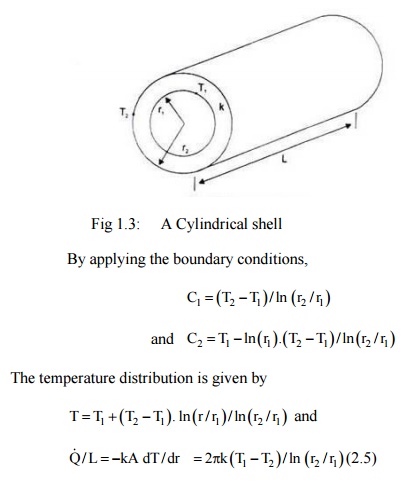Chapter: Mechanical : Heat and Mass Transfer : Conduction
One Dimensional Steady State Equation Plane Wall
ONE DIMENSIONAL STEADY STATE EQUATION
PLANE WALL :
The
term 'one-dimensional' is applied to heat conduction problem when:
(i)
Only one space coordinate is required to
describe the temperature distribution within a heat conducting body;
(ii)
Edge effects are neglected;
(iii)
The flow of heat energy takes place
along the coordinate measured normal to the surface.
A plane wall is considered
to be made out of a constant thermal conductivity material and extends to
infinity in the Y- and Z-direction. The wall is assumed to be homogeneous and
isotropic, heat flow is one-dimensional, under steady state conditions and
losing negligible energy through the edges of the wall under the above
mentioned assumptions the Eq. (2.2) reduces to
d2T
/ dx2 = 0; the boundary conditions are: at x = 0, T = T1
Integrating
the above equation, x = L, T
= T2
T
= C1x + C2, where C1 and C2 are two
constants.
Substituting
the boundary conditions, we get C2
= T1 and C1 = (T2 –T1)/L The temperature
distribution
in the plane wall is given by
T
= T1 –(T1 –T2) x/L (2.3)
which
is linear and is independent of the material.

small for the same heat flow rate,"
A Cylindrical
Shell-Expression for Temperature Distribution
In the cylindrical
system, when the temperature is a function of radial distance only and is
independent of azimuth angle or axial distance, the differential equation (2.2)
would be, (Fig. 1.4)
d2T
/dr2 +(1/r) dT/dr = 0
with boundary conditions: at r = rl, T =
T1 and at r = r2, T = T2.
The differential equation can be written as:

upon
integration, T = C1 ln (r) + C2, where C1 and
C2 are the arbitrary constants.
From Eq (2.5) It can be seen that the temperature
varies 10gantJunically through the cylinder wall In contrast with the linear
variation in the plane wall .


where A2 and A1 are
the outside and
inside surface areas
respectively. The term Am is
called
‘Logarithmic Mean
Area' and the
expression for heat low through a cylidercal wall has the same
form as that for a plane wall.

Related Topics